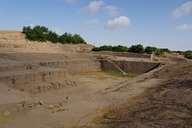Before knowing the sources of Indus Valley civilization it is very important to know some important points of this civilization.
The Harappan Civilization is called so because the civilization was first unearthed at Harappa in the province of West Punjab in Pakistan. In 1862, Sir Alexander Cunningham noticed the traits of the cities.

Later, while collecting bricks for the laying down of a railway line, the cities of Harappa and Mohenjo-Daro were discovered. In 1921, Dayaram Sahni discovered Harappa and R. D. Banerjee discovered Mohenjodaro.
Other cities which were discovered alongside Harappa and Mohenjo-Daro were Lothal, Dholavira and Surkotada (present Gujarat), Kalibangan (present Rajasthan), and Chanhudaro (present Pakistan).
The civilization encompassing these cities came to be known as the Indus Valley Civilization as it developed on the banks of River Indus and its tributaries. Sources of Indus Valley Civilization are as follows
Sources of Indus Valley Civilization
Archaeological remains of the civilization such as seals, pottery, sculptures, and buildings are one of the main sources of the Indus Valley Civilization. Archaeological sources of the civilization:
The Great Bath
- The Great Bath discovered at Mohenjo-Daro revealed that the people had attained a high level of perfection in the art of building.
- It has been suggested that the Great Bath was used for bathing during religious ceremonies.
- It is also suggested that perhaps a hierarchal structure existed in a society where the ruling class collected taxes to build structures for public use.
The Citadel
- The cities of the civilization were divided into two parts – lower and upper. The elevated portion of the city is known as the citadel.
- Important buildings such as the Great Bath, granary, assembly halls and workshops were built in this part of the city.
- The citadel points towards elaborate and efficient planning of the city which justifies that the Harappan Civilization was an urban civilisation.
- The presence of some houses on the elevated platform and some on the lower parts of the city indicates that perhaps society was divided into the ruling and ruled classes.
Seals
- About 2,000 seals were discovered at the sites of Harappa and Mohenjo-Daro.
- Most of these seals were rectangular and square in shape. They bear the images of a one-horned bull, goat, tiger, elephant and rhinoceros. The western part of the city was built on the higher platform known as the citadel.
- These seals reveal the trade, religious beliefs and script of the people. The seal with an image of Pashupati shows that perhaps people believed in lord Shiva.
- Seals also tell us about the trading practices of the period. The discovered seals show that the Harappans were trading with other civilizations as many Harappan seals were found in Mesopotamia.
Bearded Man and Dancing Girl
- The discovery of the sculpture of a bearded man from Mohenjo-Daro with a shawl worn over his left shoulder and half-closed eyes is considered a sculpture of a yogi.
- This sculpture points toward the existence of skilled artisans in the Indus Valley Civilization.
- Similarly, the bronze sculpture of a dancing girl also indicates skilled craftsmanship.
Cemeteries
- The burials of people in the Indus Valley Civilization give us an idea about the religious rituals, beliefs and practices of the people.
- These cemeteries were found in Lothal, Kalibangan and Rupar. Excavation of various goods such as animals, copper, and shell spoons with dead bodies indicates that perhaps people believed in life after death.
Dockyard
The Discovery of a rectangular dockyard at Lothal in Gujarat indicates that the people had maritime trade relations with other civilizations.
Script
- The Harappans used a pictographic script with signs representing birds, animals, fish and varieties of human forms.
- There are about 375–400 signs of the Harappan script.
- The Harappan script has not been deciphered yet.
Also, Read
Finished Reading Sources of Indus Valley Civilization? We have more content for you…
The Harappan Civilisaion
The Harappan Civilization is called so because the civilization was first unearthed at Harappa in the province of West Punjab in Pakistan. In 1862, Sir Alexander Cunningham noticed the traits of the cities. Read more
The Mauryan Empire
The Mauryan Empire is regarded as the first and one of the greatest empires in India. It is called an empire because it annexed and brought several smaller states under its control. Read more
South India and Cholas
The Chera kingdom was one of the earliest kingdoms in South India. They were later defeated by the Pallavas in the 4th century AD. Read more
Emergence of Composite Culture
The assimilation of the Turkish, Arabic and Persian cultures with Hinduism, Buddhism and Jainism led to the development of a new culture known as the Indo-Islamic culture. Read more